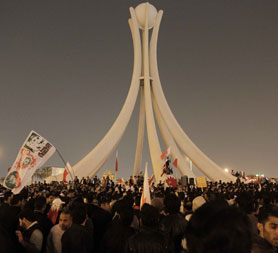The uncertainty that began in Tunisia and Egypt is now infecting Bahrain and this is causing jitters in the oil market, despite the fact that these three countries contribute relatively little to the global supply.
However there is genuine concern that the unrest will spread to the world’s largest oil producer, Saudi Arabia and this may cause serious disruptions in oil supply, pushing up crude prices to record levels.
The situation in Bahrain is very fluid and seem to be steadily worsening by the day, enough to make Formula One Administration to reconsider whether they should relocate the season opener to a safer venue.
Combine these market nerves with strong recovery demand in 2010 rolling into this year, oil prices can only hold on to their current position near the USD100 mark.
Brent is now pushing USD103 for the past week and fluctuated in a narrow band that never breached below the USD100 mark and if market analysts are correct, prices will remain firm for the near future.
The strong prices did not show any sign of softening even after the US began releasing their stockpile after traditional rundown for Christmas and New Year and analysts saying supply would have no ptoblems meeting existing demand.
Jim Burkhard, Managing Director of the IHS Global Oil Group says that a number of factors kept oil prices within the USD70-80 range for much of 2010 – at least until recently.
All the numbers indicate that the supply situation in 2010 is far more comfortable than in 2003-2007 but still prices remained strong.
UniCredit Securities Oil and gas analyst, Artem Konchin, says the 2010 oil environment reflected the interplay between demand and global macroeconomic circumstances.
“Basically, 3 major factors were driving the oil market in 2010. First, it’s currency volatility, which increased people’s interest in oil as a safer asset. Second, it’s inflationary expectations and finally America’s injections into the economy, with investors waiting for the market reaction on how this would influence global demand.”
Konchin believes crude prices will average about $85/bbl over the course of 2011, with the driving factors remaining similar to 2010, but also with an increase focus on the role of speculation in the crude markets.
“I think that the key factors and tendencies will remain virtually the same, with the volume reserve capacity, or, to be more exact, the speed of their exploration being one of the strongest drivers.
He believed that inflationary expectations in China will remain a big factor and, in 2011 the market will make an attempt to get closer to a fair oil price and get rid of speculative factors.
So, some legislation changes concerning the oil trade could be introduced, ” he added.






No comments:
Post a Comment